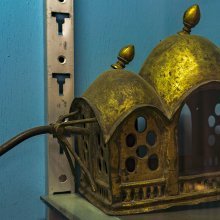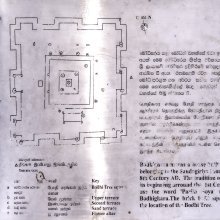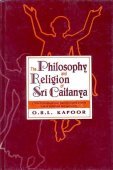Mena, Menā, Meṇa, Mēṉa, Mēṉā: 20 definitions
Introduction:
Mena means something in Buddhism, Pali, Hinduism, Sanskrit, Jainism, Prakrit, Marathi, biology, Tamil. If you want to know the exact meaning, history, etymology or English translation of this term then check out the descriptions on this page. Add your comment or reference to a book if you want to contribute to this summary article.
Images (photo gallery)
In Hinduism
Purana and Itihasa (epic history)
Source: archive.org: Puranic Encyclopedia1) Menā (मेना).—Wife of Himavān. Beautiful Menā was the daughter of Mahāmeru.
Himavān lord of the mountains and the seat of many minerals and fossils had two daughters of unparallelled beauty and their mother was the lovely Menā, daughter of Mahāmeru and wife of Himavān. (Sarga 35, Bāla Kāṇḍa, Vālmīki Rāmāyaṇa).
Rāmāyaṇa states that Menā had two daughters of extraordinary beauty named Gaṅgā and Umā. They were both married by Śiva.
But Vāmana Purāṇa in chapter 51 states that Menā had three beautiful daughters and a son named Sunābha. Menā’s first daughter was Rāgiṇī with red body and eyes and wearing a red dress. Her second daughter named Kuṭilā was white in colour, had lotus eyes, and wore white dress. The third was a girl of enchanting beauty named Kālī. She was blue-black in colour with eyes like the blue lotus leaf.
It can be surmised that the Umā of Rāmāyaṇa and Kālī were one and the same person by the following verse in the Amarakośa.
"umā kātyāyanī gaurī kālī haimavatīśvarī //"
When the statements of the two Purāṇas are taken together Menā should have had four daughters, Gaṅgā, Rāgiṇī, Kuṭilā and Kālī and a son named Sunābha.
2) Menā (मेना).—Daughter of the Pitṛs (Manes). Pitṛs are of two kinds: Anagnis and Sāgnis. Anagnis are those who do not perform yāgas and those who perform yāgas are called Sāgnis. Anagnis are called Agniṣvāttas and Sāgnis are called Barhiṣadas. Svadhā was the common wife of all the Pitṛs. Svadhā got two daughters, Menā and Dhāriṇī. They were both very welllearned, virtuous girls and were Brahmavādinīs (expounders of Vedānta philosophy). (Chapter 10, Aṃśa 1, Viṣṇu Purāṇa).
Source: archive.org: Shiva Purana - English TranslationMenā (मेना) is one of the three daughters of Svadhā who is one of the sixty daughters of Dakṣa, according to the Śivapurāṇa 2.3.2.
Accordingly, as Brahmā narrated to Nārada:—
“[...] the daughter Svadhā was given to the forefathers. She had three daughters all of whom were of handsome features and virtuous forms. O excellent sage, listen to their holy names which remove obstacles and confer blessings. Menā was the eldest. Dhanyā was the middle. Kalāvatī was the youngest. All these were mentally conceived daughters of the forefathers. They were not born of the womb of Svadhā. They were conventionally considered her children. On reciting their names, men can achieve their desires”.
Menā (मेना) or Menakā is mentioned as the wife of Himavat and the mother of Pārvatī, according to the Śivapurāṇa 2.3.1.
Accordingly, as Brahmā narrated to Nārada:
“[...] when the great goddess Satī, the daughter of Dakṣa, was sporting about on the Himālayas with Śiva, Menā, the beloved of Himācala thought that she was her own daughter and loved her like a mother with all kinds of nourishments. When the great Goddess Satī, the daughter of Dakṣa who had been to her father’s sacrifice and who did not receive his due attention became angry and cast off her body, at the very same time, O sage, Himācala’s beloved Menā wanted to propitiate her in Śivaloka”.
Note: Menā or Menakā, the wife of Himavat and the mother of Pārvatī, was one of the three daughters of Svadhā, the wife of Kavi, a class of Pitṛs. Svadhā was one of the sixty daughters of Dakṣa and Prasūti who gave birth to Menā, Dhanyā and Kalāvatī.
Menā was cursed by Sanatkumāra according to the Śivapurāṇa 2.3.2.—Accordingly, as Sanatkumāra said to the three sisters:—“[...] O ye three daughters of forefathers (i.e., Menā), listen with pleasure to my words that will dispel your sorrow and bestow happiness on you. May the eldest among you become the wife of Himavat the mountain that is a part of Viṣṇu. Pārvatī shall be her daughter. [...] The Yoginī Menā shall attain the great region Kailāsa along with her body and in the company of her husband due to the boon of Pārvatī. [...] Ye the daughters of forefathers (i.e., Menā) shall shine in heaven. By the vision of Viṣṇu your evil actions have been quelled. [...] Menā’s daughter, goddess Pārvatī, the mother of the universe shall become Śiva’s beloved after performing severe penance”.
Source: Cologne Digital Sanskrit Dictionaries: The Purana Index1) Mena (मेन).—The father of Menakā.*
- * Brahmāṇḍa-purāṇa III. 7. 17; Vāyu-purāṇa 69. 52.
2a) Menā (मेना).—A Pitṛkanyā; mind-born daughter of Agniṣvātta Pitṛs; queen of Himavān; had two sons Maināka and Krauñca (son of Maināka, Vāyu-purāṇa) and three daughters, Umā, (Ekapāṭalā, Vāyu-purāṇa) Ekaparṇā and Aparṇā who married respectively Rudra, Asita and Jaigīṣavya (Devara, Vāyu-purāṇa); the second took to the nyagrodha and pāṭala trees; the first performed tapas for thousands of years, whom the mother said “So-mā”, and hence Umā; on the eve of her giving birth to Umā, the goddess of Night entered her eyes; persuaded by the seven sages Menā and Himavān gave Umā in marriage to Śiva; and their son was the warrior God;1 spoke to Umā of her poverty-stricken husband, Maheśvara living in their house after marriage.2
- 1) Bhāgavata-purāṇa IV. 7. 58; Brahmāṇḍa-purāṇa III. 9. 2; 10. 6-20; Matsya-purāṇa 13. 7; 154. 86-93, 413; Vāyu-purāṇa 30. 28-9, 31-2; 71. 3; 92. 31; Viṣṇu-purāṇa I. 8. 14; Brahmāṇḍa-purāṇa II. 13. 30 ff. 77.
- 2) Ib. III. 67. 34.
2b) A daughter of Svadhā and Pitṛs. A Brahmavādinī.*
- * Viṣṇu-purāṇa I. 10. 19.
Menā (मेना) refers to the name of a River mentioned in the Mahābhārata (cf. VI.10.22). Note: The Mahābhārata (mentioning Menā) is a Sanskrit epic poem consisting of 100,000 ślokas (metrical verses) and is over 2000 years old.
Source: Shodhganga: The saurapurana - a critical studyMenā (मेना) refers to one of the two daughters of Pitṛ and Svadhā: one of the twenty-four daughters of Dakṣa and Prasūti, according to the Vaṃśa (‘genealogical description’) of the 10th century Saurapurāṇa: one of the various Upapurāṇas depicting Śaivism.—Accordingly, Ākūti was married to Ruci and Prasūti to Dakṣa. Dakṣa produced in Prasūti twenty-four daughters. [...] [Svadhā was given to Pitṛs.] Pitṛ and Svadhā had two daughters—Menā and Dhāriṇi. Menā was given in marriage to Himavān who begot two sons—Maināka and Krauñca and two daughters—Gaurī and Gaṅgā.

The Purana (पुराण, purāṇas) refers to Sanskrit literature preserving ancient India’s vast cultural history, including historical legends, religious ceremonies, various arts and sciences. The eighteen mahapuranas total over 400,000 shlokas (metrical couplets) and date to at least several centuries BCE.
Ayurveda (science of life)
Source: Ancient Science of Life: Vaidyavallabha: An Authoritative Work on Ayurveda TherapeuticsMeṇa (मेण) is a Sanskrit technical term referring to “wax”, and is dealt with in the 17th-century Vaidyavallabha written by Hastiruci.—The Vaidyavallabha is a work which deals with the treatment and useful for all 8 branches of Ayurveda. The text Vaidyavallabha (mentioning meṇa) has been designed based on the need of the period of the author, availability of drugs during that time, disease manifesting in that era, socio-economical-cultural-familial-spiritual-aspects of that period Vaidyavallabha.

Āyurveda (आयुर्वेद, ayurveda) is a branch of Indian science dealing with medicine, herbalism, taxology, anatomy, surgery, alchemy and related topics. Traditional practice of Āyurveda in ancient India dates back to at least the first millenium BC. Literature is commonly written in Sanskrit using various poetic metres.
In Buddhism
Tibetan Buddhism (Vajrayana or tantric Buddhism)
Source: Wisdom Library: Tibetan Buddhism1) Menā (मेना) is the name of a Yakṣiṇī mentioned as attending the teachings in the 6th century Mañjuśrīmūlakalpa: one of the largest Kriyā Tantras devoted to Mañjuśrī (the Bodhisattva of wisdom) representing an encyclopedia of knowledge primarily concerned with ritualistic elements in Buddhism. The teachings in this text originate from Mañjuśrī and were taught to and by Buddha Śākyamuni in the presence of a large audience (including Menā).

Tibetan Buddhism includes schools such as Nyingma, Kadampa, Kagyu and Gelug. Their primary canon of literature is divided in two broad categories: The Kangyur, which consists of Buddha’s words, and the Tengyur, which includes commentaries from various sources. Esotericism and tantra techniques (vajrayāna) are collected indepently.
In Jainism
General definition (in Jainism)
Source: archive.org: TrisastisalakapurusacaritraMenā (मेना) is the name of an Apsaras, instructed by Śakra to help in the preparations of Ṛṣabha’s wedding-preparations, according to chapter 1.2 [ādīśvara-caritra] of Hemacandra’s 11th century Triṣaṣṭiśalākāpuruṣacaritra: an ancient Sanskrit epic poem narrating the history and legends of sixty-three illustrious persons in Jainism.
Accordingly,
“[...] Then having ascertained the Lord’s purpose, Purandara at once summoned gods for the tasks of the wedding-preparations.—‘[...] Menā, receive with delightful conversation the ones who have arrived. Sukeśī, bring the hair-omaments for the brides and groom; Sahajanyā, show the place to the men of the wedding procession. [...]’. From the bustling of the Apsarases instructing each other in this way, and frequently calling names, a mighty tumult arose”.

Jainism is an Indian religion of Dharma whose doctrine revolves around harmlessness (ahimsa) towards every living being. The two major branches (Digambara and Svetambara) of Jainism stimulate self-control (or, shramana, ‘self-reliance’) and spiritual development through a path of peace for the soul to progess to the ultimate goal.
Biology (plants and animals)
Source: Google Books: CRC World Dictionary (Regional names)Mena in India is the name of a plant defined with Tamarix gallica in various botanical sources. This page contains potential references in Ayurveda, modern medicine, and other folk traditions or local practices It has the synonym Tamarix gallica Thunb. (among others).
Example references for further research on medicinal uses or toxicity (see latin names for full list):
· Species Plantarum (1753)
· Flora Japonica (Thunberg) (1784)
· Fl. Ross. (Pallas) (1789)
If you are looking for specific details regarding Mena, for example diet and recipes, chemical composition, pregnancy safety, health benefits, side effects, extract dosage, have a look at these references.

This sections includes definitions from the five kingdoms of living things: Animals, Plants, Fungi, Protists and Monera. It will include both the official binomial nomenclature (scientific names usually in Latin) as well as regional spellings and variants.
Languages of India and abroad
Marathi-English dictionary
Source: DDSA: The Molesworth Marathi and English Dictionarymēṇa (मेण).—n Wax. 2 fig. Softly and nicely boiled rice, split pulse &c. mēṇa kāḍhaṇēṃ g. of o. To beat soundly. mēṇa svastha hōṇēṃ g. of s. To get fat and sleek. mēṇa hōṇēṃ To soften down into gentleness or mildness.
--- OR ---
mēṇa (मेण).—n (Or myāna from P) A scabbard. ēkā mēṇānta dōna suṛyā (samāvaṇēṃ-rāhaṇēṃ &c.) Phrase implying the impossibility of great potentates, warriors, scholars, or other great ones, or of conflicting dispositions or geniuses, dwelling together in peace and concord. Ex. tukayācī pratiṣṭhā vāḍhatāṃ tēthēṃ || tyācē manīṃ dvēṣa upajata || mhaṇē ēkā mēṇānta dōna suṛyā niścitta || samāvati kaiśā parī ||. 2 Used also to intimate the necessary ill performance or management of a business in the hands of two persons.
--- OR ---
mēṇā (मेणा).—m ( P) A palanquin. This is the proper term. See pālakhī.
--- OR ---
mēṇā (मेणा) [or ण्या, ṇyā].—a (mēṇa) Smeared with a composition of wax, dregs of oil or ghee, ashes of burnt rags and cowdung &c. Used of ṭōpalēṃ, sūpa, pāṇṭī, harā &c.
--- OR ---
mēnā (मेना).—m (Or mēṇā from P) A palanquin.
Source: DDSA: The Aryabhusan school dictionary, Marathi-Englishmēṇa (मेण).—n Wax. A scabbard. mēṇa kāḍhaṇēṃ Beat soundly. ēkā mēṇyānta dōna suṛyā A phrase implying the impossibility of great geniuses dwelling together in con- cord.
--- OR ---
mēṇā (मेणा).—m A palanquin.
--- OR ---
mēnā (मेना).—m A palanquin.
Marathi is an Indo-European language having over 70 million native speakers people in (predominantly) Maharashtra India. Marathi, like many other Indo-Aryan languages, evolved from early forms of Prakrit, which itself is a subset of Sanskrit, one of the most ancient languages of the world.
Sanskrit dictionary
Source: DDSA: The practical Sanskrit-English dictionaryMenā (मेना).—
1) Name of the wife of Himālaya; मेनां मुनीनामपि माननीयाम् (menāṃ munīnāmapi mānanīyām) (upayeme) Kumārasambhava 1.18;5.5.
2) Name of a river.
3) speech (vāc).
Source: Cologne Digital Sanskrit Dictionaries: Shabda-Sagara Sanskrit-English DictionaryMenā (मेना).—f.
(-nā) The wife of Himalaya: see menakā .
Source: Cologne Digital Sanskrit Dictionaries: Benfey Sanskrit-English DictionaryMenā (मेना).—f. One of the courtesans of heaven, and wife to Himālaya, [Rāmāyaṇa] 1, 37, 15 Gorr.
Source: Cologne Digital Sanskrit Dictionaries: Cappeller Sanskrit-English DictionaryMenā (मेना).—[feminine] wife, female.
Source: Cologne Digital Sanskrit Dictionaries: Monier-Williams Sanskrit-English Dictionary1) Mena (मेन):—m. Name of Vṛṣan-aśva (father of Menakā or Menā), [ṢaḍvBr.]
2) Menā (मेना):—[from mena] a f. See below.
3) [from mena] b f. a woman (also the female of any animal), [Ṛg-veda]
4) [v.s. ...] speech (= vāc), [Naighaṇṭuka, commented on by Yāska i, 11]
5) [v.s. ...] Name of the daughter of Vṛṣaṇ-aśva, [Ṛg-veda i, 51, 13] ([Sāyaṇa])
6) [v.s. ...] of an Apsaras (= menakā, wife of Hima-vat and mother of Parvatī), [Harivaṃśa; Rāmāyaṇa; Purāṇa]
7) [v.s. ...] of a river, [Mahābhārata]
Source: Cologne Digital Sanskrit Dictionaries: Yates Sanskrit-English DictionaryMenā (मेना):—(nā) 1. f. The wife of Himālaya.
[Sanskrit to German]
Sanskrit, also spelled संस्कृतम् (saṃskṛtam), is an ancient language of India commonly seen as the grandmother of the Indo-European language family (even English!). Closely allied with Prakrit and Pali, Sanskrit is more exhaustive in both grammar and terms and has the most extensive collection of literature in the world, greatly surpassing its sister-languages Greek and Latin.
Kannada-English dictionary
Source: Alar: Kannada-English corpusMēṇa (ಮೇಣ):—
1) [noun] a plastic, dull-yellow substance secreted by bees for building cells; bees-wax.
2) [noun] a kind of adhesive paste prepared using the flour of some corns.
3) [noun] any of various solid or semisolid, viscous, yellowish or brownish organic substances exuded from various plants and trees, that is used as or in preparing adhesives; gum.
4) [noun] Manmatha, the Love-God.
5) [noun] compelling or strong love; passion.
6) [noun] the dark brown bird Acridotheres tristis of Sturnidae family, with yellow beak, black head, short, white bordered black tail, yellow legs; common myna.
7) [noun] ಮೇಣದ ಬಟ್ಟೆ [menada batte] mēṇada baṭṭe = ಮೇಣಗಪ್ಪಟ [menagappata]; ಮೇಣದ ಬತ್ತಿ [menada batti] mēṇada batti a long, usu. slender piece of wax with an embedded wick that is burned to give light; a candle.
--- OR ---
Mēṇā (ಮೇಣಾ):—[noun] = ಮೇನೆ [mene].
--- OR ---
Mēna (ಮೇನ):—[noun] = ಮೇನೆ [mene].
--- OR ---
Mēnā (ಮೇನಾ):—[noun] = ಮೇನೆ [mene].
--- OR ---
Mēnā (ಮೇನಾ):—[noun] the plant Fraxinus excelsior of Oleaceae family.
Kannada is a Dravidian language (as opposed to the Indo-European language family) mainly spoken in the southwestern region of India.
See also (Relevant definitions)
Starts with (+49): Menaa, Menabajara, Menabatti, Menabavali, Menaca, Menacai, Menacam, Menacata, Menacota, Menada, Menadabattimara, Menadhava, Menagapata, Menagappada, Menagappata, Menagata, Menagati, Menagattu, Menaghuna, Menagoli.
Ends with (+41): Adavi maamena, Adavimaamena, Adavimamena, Amena, Andramena, Andromena, Anukkamena, Aropitaniyamena, Ashramena, Awiem-fosemena, Behamena, Bhagyakramena, Bonaramena, Camena, Cirakramena, Ciratamena, Ciyacamena, Damena, Dharmena, Dramena.
Full-text (+1268): Menaja, Menadhava, Mainaka, Menappallakku, Amena, Menam, Uma, Menola, Menavala, Menacai, Menya, Menekari, Pirattiyakkam, Kotokwatra mena nomo, Manary mena, Sari hompi mena, Menya Maravadi, Rara mena, Menula, Menila.
Relevant text
Search found 40 books and stories containing Mena, Menā, Meṇā, Mēṇā, Mēṇa, Meṇa, Mēnā, Mēna, Mēṉa, Mēṉā; (plurals include: Menas, Menās, Meṇās, Mēṇās, Mēṇas, Meṇas, Mēnās, Mēnas, Mēṉas, Mēṉās). You can also click to the full overview containing English textual excerpts. Below are direct links for the most relevant articles:
Rig Veda (translation and commentary) (by H. H. Wilson)
The Shiva Purana (by J. L. Shastri)
Chapter 45 - Śiva’s comely form and the Jubilation of the Citizens < [Section 2.3 - Rudra-saṃhitā (3): Pārvatī-khaṇḍa]
Chapter 9 - Śiva appears before Pārvatī in dream < [Section 2.3 - Rudra-saṃhitā (3): Pārvatī-khaṇḍa]
Chapter 44 - Menā regains consciousness < [Section 2.3 - Rudra-saṃhitā (3): Pārvatī-khaṇḍa]
The Gautami Mahatmya (by G. P. Bhatt)
Satapatha-brahmana (by Julius Eggeling)
Kāṇḍa III, adhyāya 3, brāhmaṇa 4 < [Third Kāṇḍa]
The Garuda Purana (by Manmatha Nath Dutt)
Chapter V - Creation of the Prajapatis < [Agastya Samhita]
The Skanda Purana (by G. V. Tagare)
Chapter 20 - The Nirguṇatva of the Śiva Liṅga: The Manifestation of Bhavānī < [Section 1 - Kedāra-khaṇḍa]
Chapter 25 - The Marriage Rituals < [Section 1 - Kedāra-khaṇḍa]
Chapter 22 - The Birth of Pārvatī < [Section 2 - Kaumārikā-khaṇḍa]
Related products



